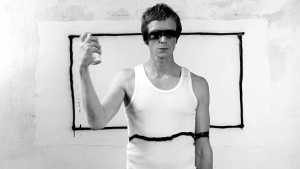Summary
The Sleeping Girl
Düsseldorf, beginning of the seventies. Hans, a young, introverted student of Beuys, meets Ruth, a young homeless woman living in a park. Fascinated by her, he takes Ruth in and makes her the subject of his video work. Ruth quickly settles into the artist scene around Hans, she gets a job as a drawing model at the academy. But Hans is skeptical about her new life, he suspects that Ruth, in her transformation to ‘glamour girl,’ is only trying to get away from herself. For him, she remains the baffling homeless girl that he had secretly fallen in love with, a subject that he doesn’t want to share with anyone. Jealous of his best friend Philipp, he locks Ruth up in his studio so he can – so he thinks – look into her secrets in the test tube of art. Art and life become inextricably intertwined.
In front of the backdrop of the skeptical post ’68 years, "The Sleeping Girl" presents a portrait of two dissimilar loners who are apparently trying to use each other to get a grip on their damaged lives. Made in the style of a self-reflexive video experiment, but with the dramatic means of narrative cinema, the film brings alive a time in which the first portable video systems were becoming popular among artists and in which a significant period in performance art was shaping up parallel to the rising video culture.
"The Sleeping Girl" is a fictional artist film. Its documentary style grounds the psychological movement of history, it is the organic component of narration. We experience the events through Hans’s gaze, every image is marked by his artistic vision – it is Hans’s film that we see. the dramatic action takes place at the point of friction between Hans’s intentions and the unpredicted, which enters in without – and often contrary to – his cooperation. So the film has Hans depicting his own loss of control, we participate in a battle over the grandeur of the image, a battle with the reality of the event, the central form of which is Ruth.
But Hans’s artistic program has nothing to do with protocol: he is an active artist, himself the protagonist of his own images. He examines the elementary peculiarities of the medium–film character in space, relation of the visual space to real space–and his own relation as well. Like the Dutch artist Bas Jan Ader, who died very young and is my historical model, Hans creates himself as a melancholy-ironic, Buster-Keaton-type art figure, who encounters the adversities of reality with stoic patience, consequently becoming the pawn of the game. Hans’s film is therefore always also a project of self-examination, in which the difference between artistic figure and the real Hans creates the spark for the dramatic action.
Rainer Kirberg
Source: 61. Internationale Filmfestspiele Berlin (Catalogue)

Comments
You have seen this movie? We are looking forward to your comment!
Login or register now to write a comment.